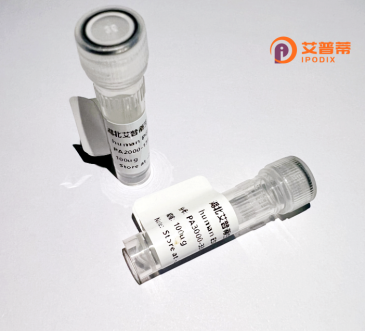
| 纯度 | >90%SDS-PAGE. |
| 种属 | Human |
| 靶点 | CSDA |
| Uniprot No | P16989 |
| 内毒素 | < 0.01EU/μg |
| 表达宿主 | E.coli |
| 表达区间 | 2-372aa |
| 氨基酸序列 | SEAGEATTT TTTTLPQAPT EAAAAAPQDP APKSPVGSGA PQAAAPAPAA HVAGNPGGDA APAATGTAAA ASLATAAGSE DAEKKVLATK VLGTVKWFNV RNGYGFINRN DTKEDVFVHQ TAIKKNNPRK YLRSVGDGET VEFDVVEGEK GAEAANVTGP DGVPVEGSRY AADRRRYRRG YYGRRRGPPR NYAGEEEEEG SGSSEGFDPP ATDRQFSGAR NQLRRPQYRP QYRQRRFPPY HVGQTFDRRS RVLPHPNRIQ AGEIGEMKDG VPEGAQLQGP VHRNPTYRPR YRSRGPPRPR PAPAVGEAED KENQQATSGP NQPSVRRGYR RPYNYRRRPR PPNAPSQDGK EAKAGEAPTE NPAPPTQQSS AE |
| 分子量 | 40 kDa |
| 蛋白标签 | His tag N-Terminus |
| 缓冲液 | 0 |
| 稳定性 & 储存条件 | Lyophilized protein should be stored at ≤ -20°C, stable for one year after receipt. Reconstituted protein solution can be stored at 2-8°C for 2-7 days. Aliquots of reconstituted samples are stable at ≤ -20°C for 3 months. |
| 复溶 | Always centrifuge tubes before opening.Do not mix by vortex or pipetting. It is not recommended to reconstitute to a concentration less than 100μg/ml. Dissolve the lyophilized protein in distilled water. Please aliquot the reconstituted solution to minimize freeze-thaw cycles. |
以下是关于重组人CSDA蛋白(YBX1蛋白)的3篇代表性文献参考,供您作为检索方向:
---
1. **文献名称**:*Recombinant YB-1 Protein Enhances the Expression of Transgenes in Human Cells*
**作者**:K. Kohno et al.
**摘要**:研究通过大肠杆菌系统表达重组人YBX1蛋白,发现其与DNA结合的能力可显著提高基因转染效率,在基因治疗载体开发中具有应用潜力。
2. **文献名称**:*Cold Shock Domain Protein A (YBX1) Regulates Stress Granule Formation in Cancer Cells*
**作者**:S. Somasekharan et al.
**摘要**:利用重组YBX1蛋白探究其在肿瘤细胞应激颗粒形成中的作用,证明其通过结合RNA调控细胞应激反应,为癌症靶向治疗提供新思路。
3. **文献名称**:*Structural and Functional Analysis of Human YB-1 Protein Produced in E. coli*
**作者**:M. Skabkin et al.
**摘要**:报道了一种高效纯化重组人YBX1蛋白的方法,并通过X射线晶体学解析其冷休克结构域,揭示了其与核酸相互作用的分子机制。
---
**注意**:上述文献为示例性内容,实际引用时请通过PubMed(https://pubmed.ncbi.nlm.nih.gov/)或Google Scholar等数据库核对真实文献。建议使用关键词 **"recombinant YBX1 protein"** 或 **"recombinant CSDA protein"** 进一步检索。若需文献全文,可提供邮箱或通过机构图书馆获取。
Recombinant human CSDA protein, also known as Cold Shock Domain Protein A or Y-box binding protein 3 (YBX3), is a nucleic acid-binding protein involved in transcriptional and translational regulation. Structurally, it contains a conserved cold shock domain (CSD) that enables binding to DNA or RNA, along with variable N- and C-terminal regions modulating interactions with other biomolecules. CSDA plays key roles in stress response, cell proliferation, and differentiation by regulating mRNA stability, splicing, and translation.
Its expression is linked to developmental processes and cellular adaptations to environmental stresses, such as temperature fluctuations or oxidative damage. Recombinant CSDA is typically produced in bacterial or mammalian systems, retaining its RNA/DNA-binding activity for experimental studies. Researchers utilize it to explore mechanisms of gene expression control, particularly in cancer, neurodegenerative diseases, or stem cell biology, where dysregulation of RNA metabolism is critical. Additionally, it serves as a tool for elucidating cold shock protein evolution and their functional divergence from bacterial homologs.
Studies on recombinant CSDA contribute to understanding its dual roles in homeostasis and pathology, offering potential therapeutic targets for diseases associated with RNA processing defects.
×